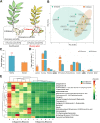Multiomics Reveals the Effect of Root Rot on Polygonati Rhizome and Identifies Pathogens and Biocontrol Strain
- PMID: 35225655
- PMCID: PMC9045327
- DOI: 10.1128/spectrum.02385-21
Multiomics Reveals the Effect of Root Rot on Polygonati Rhizome and Identifies Pathogens and Biocontrol Strain
Abstract
Root (rhizome) rot of Polygonatum plants has received substantial attention because it threatens yield and sustainable utilization in the polygonati rhizome industry. However, the potential pathogens that cause rhizome rot as well as the direct and indirect (via root-associated microbes) strategies by which Polygonatum defends against pathogens remain largely unknown. Herein, we used integrated multiomics of plant-targeted metabolomics and transcriptomics, microbiome, and culture-based methods to systematically investigate the interactions between the Polygonatum cyrtonema Hua root-associated microbiota and pathogens. We found that root rot inhibited P. cyrtonema rhizome growth and that the fresh weight significantly decreased (P < 0.001). The transcriptomic and metabonomic results showed that the expression of differentially expressed genes (DEGs) related to specialized metabolic and systemic resistance pathways, such as glycolysis/gluconeogenesis and flavonoid biosynthesis, cycloartenol synthase activity (related to saponin synthesis), mitogen-activated protein kinase (MAPK) signaling, and plant hormone signal transduction, was particularly increased in diseased rhizomes. Consistently, the contents of lactose, d-fructose, sarsasapogenin, asperulosidic acid, botulin, myricadoil, and other saponins, which are functional medicinal compounds present in P. cyrtonema rhizomes, were also increased in diseased plants infected with rhizome rot. The microbiome sequencing and culture results showed that root rot disrupted the P. cyrtonema bacterial and fungal communities and reduced the microbial diversity in the rhizomes and rhizosphere soil. We further found that a clear enrichment of Streptomyces violascens XTBG45 (HJB-XTBG45) in the healthy rhizosphere could control the root rot caused by Fusarium oxysporum and Colletotrichum spaethianum. Taken together, our results indicate that P. cyrtonema can modulate the plant immune system and metabolic processes and enrich beneficial root microbiota to defend against pathogens. IMPORTANCE Root (rhizome or tuber) reproduction is the main method for the agricultural cultivation of many important cash crops, and infected crop plants rot, exhibit retarded growth, and experience yield losses. While many studies have investigated medicinal plants and their functional medicinal compounds, the occurrence of root (rhizome) rot of plant and soil microbiota has received little attention. Therefore, we used integrated multiomics and culture-based methods to systematically study rhizome rot on the famous Chinese medicine Polygonatum cyrtonema and identify pathogens and beneficial microbiota of rhizome rot. Rhizome rot disrupted the Polygonatum-associated microbiota and reduced microbial diversity, and rhizome transcription and metabolic processes significantly changed. Our work provides evidence that rhizome rot not only changes rhizome transcription and functional metabolite contents but also impacts the microbial community diversity, assembly, and function of the rhizome and rhizosphere. This study provides a new friendly strategy for medicinal plant breeding and agricultural utilization.
Keywords: PSM; Streptomyces; medicinal plant; polysaccharide and saponins; rhizome rot; root microbiota.
Conflict of interest statement
The authors declare no conflict of interest.
Figures





Similar articles
-
PcMYBs responded to 6-BA to regulate PcCKXs to promote germination of primary rhizome buds of Polygonatum cyrtonema Hua.BMC Plant Biol. 2025 Aug 18;25(1):1082. doi: 10.1186/s12870-025-06827-w. BMC Plant Biol. 2025. PMID: 40820132 Free PMC article.
-
Metabolome-driven microbiome assembly determining the health of ginger crop (Zingiber officinale L. Roscoe) against rhizome rot.Microbiome. 2024 Sep 7;12(1):167. doi: 10.1186/s40168-024-01885-y. Microbiome. 2024. PMID: 39244625 Free PMC article.
-
Autotoxin Rg1 Induces Degradation of Root Cell Walls and Aggravates Root Rot by Modifying the Rhizospheric Microbiome.Microbiol Spectr. 2021 Dec 22;9(3):e0167921. doi: 10.1128/spectrum.01679-21. Epub 2021 Dec 15. Microbiol Spectr. 2021. PMID: 34908454 Free PMC article.
-
Home treatment for mental health problems: a systematic review.Health Technol Assess. 2001;5(15):1-139. doi: 10.3310/hta5150. Health Technol Assess. 2001. PMID: 11532236
-
Signs and symptoms to determine if a patient presenting in primary care or hospital outpatient settings has COVID-19.Cochrane Database Syst Rev. 2022 May 20;5(5):CD013665. doi: 10.1002/14651858.CD013665.pub3. Cochrane Database Syst Rev. 2022. PMID: 35593186 Free PMC article.
Cited by
-
Foliar Pathogen Infection Manipulates Soil Health through Root Exudate-Modified Rhizosphere Microbiome.Microbiol Spectr. 2022 Dec 21;10(6):e0241822. doi: 10.1128/spectrum.02418-22. Epub 2022 Nov 29. Microbiol Spectr. 2022. PMID: 36445116 Free PMC article.
-
The change of bacterial community structure helped Salvia miltiorrhiza alleviate the pressure of drought stress.Front Plant Sci. 2025 Jul 30;16:1642597. doi: 10.3389/fpls.2025.1642597. eCollection 2025. Front Plant Sci. 2025. PMID: 40810023 Free PMC article.
-
Catalog of operational taxonomic units and unified amplicon sequencing data for the microbiomes of medicinal plant roots.Eng Microbiol. 2023 Apr 14;3(3):100087. doi: 10.1016/j.engmic.2023.100087. eCollection 2023 Sep. Eng Microbiol. 2023. PMID: 39628929 Free PMC article.
-
Multi-Omics Analysis Reveals the Resistance Mechanism and the Pathogens Causing Root Rot of Coptis chinensis.Microbiol Spectr. 2023 Feb 21;11(2):e0480322. doi: 10.1128/spectrum.04803-22. Online ahead of print. Microbiol Spectr. 2023. PMID: 36809123 Free PMC article.
-
Maize and peanut intercropping improves the nitrogen accumulation and yield per plant of maize by promoting the secretion of flavonoids and abundance of Bradyrhizobium in rhizosphere.Front Plant Sci. 2022 Aug 4;13:957336. doi: 10.3389/fpls.2022.957336. eCollection 2022. Front Plant Sci. 2022. PMID: 35991432 Free PMC article.
References
Publication types
MeSH terms
Substances
LinkOut - more resources
Full Text Sources
Miscellaneous

